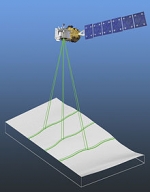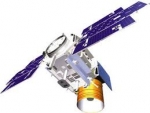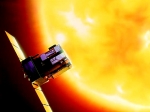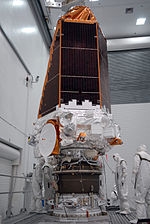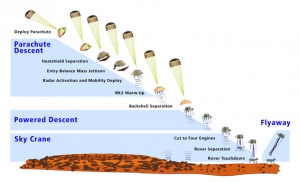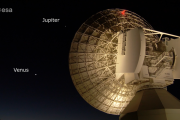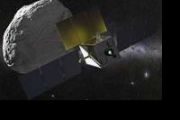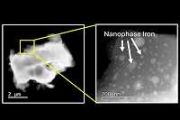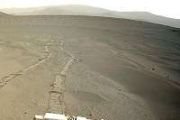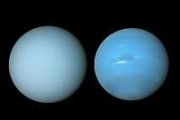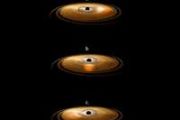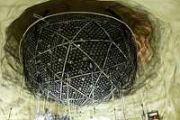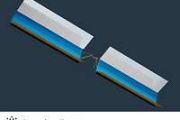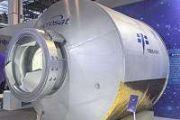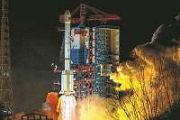Displaying items by tag: NASA
IceBridge
IceBridge, a six-year NASA mission, is the largest airborne survey of Earth's polar ice ever flown. It will yield an unprecedented three-dimensional view of Arctic and Antarctic ice sheets, ice shelves and sea ice. These flights will provide a yearly, multi-instrument look at the behavior of the rapidly changing features of the Greenland and Antarctic ice.
Data collected during IceBridge will help scientists bridge the gap in polar observations between NASA's Ice, Cloud and Land Elevation Satellite (ICESat) -- in orbit since 2003 -- and ICESat-2, planned for early 2016. ICESat stopped collecting science data in 2009, making IceBridge critical for ensuring a continuous series of observations.
IceBridge will use airborne instruments to map Arctic and Antarctic areas once a year. IceBridge flights are conducted in March-May over Greenland and in October-November over Antarctica. Other smaller airborne surveys around the world are also part of the IceBridge campaign.
ICESat-2
ICESat-2 (Ice, Cloud, and land Elevation Satellite 2), part of NASA's Earth Observing System, is a planned (year of writting: 2012) satellitemission for measuring ice sheet mass elevation, sea ice freeboard as well as land topography and vegetation characteristics. ICESat-2 is a planned follow-on to the ICESat mission. It will be launched in 2016 from Vandenberg Air Force Base in California into a near-circular, near-polar orbit with an altitude of approximately 496 km. It is being designed to operate for 3 years, and will carry enough propellant for 7 years.
The ICESat-2 mission is designed to provide elevation data needed to determine ice sheet mass balance as well as vegetation coverage information. It provides topography and vegetation data around the globe, in addition to the polar-specific coverage over the polar regions.
The ICESat-2 project is being managed by NASA Goddard Space Flight Center. The sole instrument is being designed and built by NASA Goddard Space Flight Center, and the bus is being provided by Orbital Sciences Corporation.
ICESat
ICESat (Ice, Cloud, and land Elevation Satellite), part of NASA's Earth Observing System, was a satellite mission for measuring ice sheet mass balance, cloud and aerosol heights, as well as land topography and vegetation characteristics.
ICESat was launched 13 January 2003 on a Delta II rocket from Vandenberg Air Force Base in California into a near-circular, near-polar orbit with an altitude of approximately 600 km.
It operated for seven years before being retired in February 2010, after its scientific payload shut down and scientists were unable to restart it.
The ICESat mission was designed to provide elevation data needed to determine ice sheet mass balance as well as cloud property information, especially for stratospheric clouds common over polar areas. It provides topography and vegetation data around the globe, in addition to the polar-specific coverage over the Greenland and Antarctic ice sheets. The satellite was found useful in assessing important forest characteristics, including tree density.
Jet Propulsion Laboratory (JPL)
The Jet Propulsion Laboratory (JPL) is a federally funded research and development center and NASA field center located in California, USA. JPL is managed by the nearby California Institute of Technology (Caltech) for the National Aeronautics and Space Administration (NASA).
The Laboratory's primary function is the construction and operation of robotic planetary spacecraft, though it also conducts Earth-orbit and astronomy missions. It is also responsible for operating NASA's Deep Space Network.
Among the Laboratory's major projects are the Mars Science Laboratory mission (which includes the Curiosity rover), the Cassini–Huygens mission orbiting Saturn, the Mars Exploration Rovers (Spirit and Opportunity), the Mars Reconnaissance Orbiter, the Dawn mission to the dwarf planet Ceres and asteroid Vesta, the Juno spacecraft en route to Jupiter, the Gravity Recovery and Interior Laboratory (GRAIL) mission to the Moon, the Nuclear Spectroscopic Telescope Array (NuSTAR) X-ray telescope, and the Spitzer Space Telescope.
Terra
Terra (EOS AM-1) is a multi-national NASA scientific research satellite in a sun-synchronous orbit around the Earth.[1] It is the flagship of the Earth Observing System (EOS). The name "Terra" comes from the Latin word for Earth.
Launch
The satellite was launched from Vandenberg Air Force Base on December 18, 1999, aboard an Atlas IIAS vehicle and began collecting data on February 24, 2000.
Mission
Terra carries a payload of five remote sensors designed to monitor the state of Earth's environment and ongoing changes in its climate system:
- ASTER (Advanced Spaceborne Thermal Emission and Reflection Radiometer)
- CERES (Clouds and the Earth's Radiant Energy System)
- MISR (Multi-angle Imaging SpectroRadiometer)
- MODIS (Moderate-resolution Imaging Spectroradiometer)
- MOPITT (Measurements of Pollution in the Troposphere)
Data from the satellite helps scientists better understand the spread of pollution around the globe. Studies have used instruments on Terra to examine trends in global carbon monoxide and aerosol pollution. The data collected by Terra will ultimately become a new, 15-year global data set.
Space Shuttle program
The NASA's Space Shuttle program, officially called Space Transportation System (STS), was the United States government's manned launch vehicle program from 1981 to 2011. The winged Space Shuttle orbiter was launched vertically, usually carrying four to sevenastronauts (although eight have been carried) and up to 50,000 lb (22,700 kg) of payload intolow Earth orbit (LEO). When its mission was complete, the shuttle could independently move itself out of orbit using its Maneuvering System (it oriented itself appropriately and fired its main OMS engines, thus slowing it down) and re-enter the Earth's atmosphere. During descent and landing the orbiter acted as a re-entry vehicle and a glider, using its OMS system and flight surfaces to make adjustments.
The shuttle is the only winged manned spacecraft to have achieved orbit and land, and the only reusable space vehicle that has ever made multiple flights into orbit. Its missionsinvolved carrying large payloads to various orbits (including segments to be added to theInternational Space Station), provided crew rotation for the International Space Station, and performing service missions. The orbiter also recovered satellites and other payloads (e.g. from the ISS) from orbit and returned them to Earth, though its use in this capacity was rare. Each vehicle was designed with a projected lifespan of 100 launches, or 10 years' operational life.
The program started in the late 1960s and dominated NASA's manned operations since the mid-1970s. According to the Vision for Space Exploration, use of the space shuttle was to be focused on completing assembly of the ISS by 2011, after which it was retired. NASA planned to replace the shuttle with the Orion spacecraft, but budget cuts have placed full development of the Orion craft in doubt. The program commenced on April 12, 1981, withColumbia and STS-1, the first shuttle orbital flight. The space shuttle program finished with its last mission, STS-135 flown by Atlantis, in July 2011, retiring the final shuttle in the fleet. The Space Shuttle program formally ended on August 31, 2011.
Discovery program
NASA's Discovery Program (as compared to New Frontiers, Explorers, or Flagship Programs) is a series of lower-cost, highly-focused American scientific space missions that are exploring the Solar System. It was founded in 1992 to implement then-NASA Administrator Daniel S. Goldin's vision of "faster, better, cheaper" planetary missions. Discovery missions differ from traditional NASA missions where targets and objectives are pre-specified. Instead, these cost-capped missions are proposed and led by a scientist called the Principal Investigator (PI). Proposing teams may include people from industry, small businesses, government laboratories, and universities. Proposals are selected through a competitive peer review process. All of the completed Discovery missions are accomplishing ground-breaking science and adding significantly to the body of knowledge about the Solar System.
NASA also accepts proposals for competitively selected Discovery Program Missions of Opportunity. This provides opportunities to participate in non-NASA missions by providing funding for a science instrument or hardware components of a science instrument or to re-purpose an existing NASA spacecraft. These opportunities are currently offered through NASA's Stand Alone Mission of Opportunity program.
SOHO (mission & spacecraft)
The Solar and Heliospheric Observatory (SOHO) mission purpose is to study the Sun from a point of gravitational balance.
The SOHO spacecraft has been built by a European industrial consortium led by Matra Marconi Space (now Astrium) that was launched on a Lockheed MartinAtlas IIAS launch vehicle on December 2, 1995 to study the Sun, and has discovered over 2100 comets. It began normal operations in May 1996.
It is a joint project of international cooperation between the European Space Agency (ESA) and NASA. Originally planned as a two-year mission,SOHO currently continues to operate after over fifteen years in space. In October 2009, a mission extension lasting until December 2012 was approved.
In addition to its scientific mission, it is currently the main source of near-real time solar data for space weather prediction. Along with the GGS Wind and Advanced Composition Explorer (ACE),SOHO is one of three spacecraft currently in the vicinity of the Earth-Sun L1 point, a point of gravitational balance located approximately 0.99 astronomical unit (AU)s from the Sun and 0.01 AU from the Earth. In addition to its scientific contributions, SOHO is distinguished by being the first three-axis-stabilized spacecraft to use its reaction wheels as a kind of virtual gyroscope; the technique was adopted after an on-board emergency in 1998 that nearly resulted in the loss of the spacecraft.
Kepler (mission & spacecraft)
The Kepler spacecraft is an American space observatory, the space-based portion of NASA's Kepler mission to discover Earth-like planets orbiting other stars. The spacecraft is named in honor of the 17th-century German astronomer Johannes Kepler. The spacecraft was launched on March 7, 2009, with a planned mission lifetime of at least 3.5 years.
The Kepler mission is "specifically designed to survey a portion of our region of theMilky Way galaxy to discover dozens of Earth-size planets in or near the habitable zone and determine how many of the billions of stars in our galaxy have such planets." Kepler's only instrument is a photometer that continuously monitors the brightness of over 145,000 main sequence stars in a fixed field of view. This data isanalyzed to detect periodic fluctuations that indicate the presence of extrasolar planets that are in the process of crossing the face of other stars.
The MSL mission (Mars Science Laboratory)
The Mars Science Laboratory (MSL) is a National Aeronautics and Space Administration (NASA) mission with the aim to land and operate a rover named Curiosity on the surface of Mars.
The MSL was launched November 26, 2011 at 10:02 am EST and will land on Mars at Gale Craterbetween August 6 and August 20, 2012. It will attempt to perform the first-ever precision landing on Mars. The rover Curiosity will help assess Mars' habitability, that is, whether Mars is, or ever was an environment able to support microbial life. It will also analyze samples scooped up from the soil and drilled powders from rocks.


